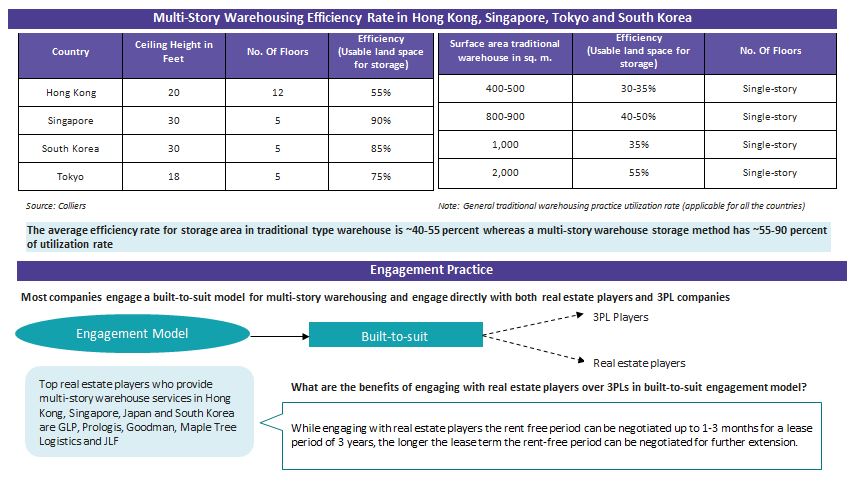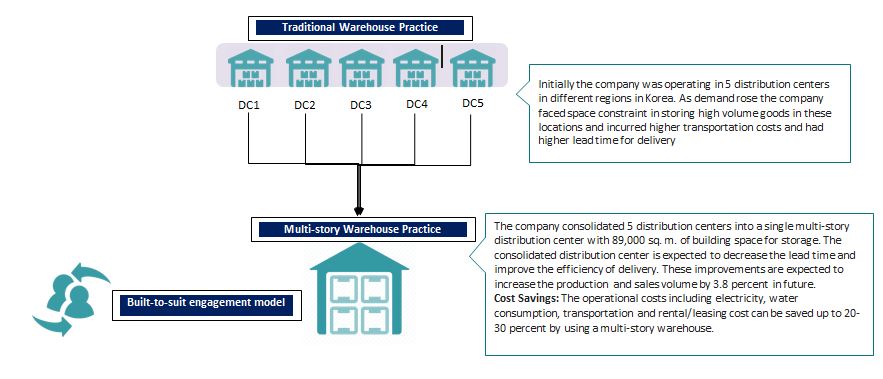
Multi-story warehousing can be a cost-effective option for procurers in high-cost locations

Abstract:
High-cost locations such as Hong Kong, Singapore, South Korea and Japan have limited land availability which is pushing up the rental rates for traditional warehouses. Traditional warehousing setup requires two or more warehouses in different locations. This is increasing the transportation cost and the lead time of the delivery. Manufacturing and procurement organizations are therefore paying higher rental rates for different warehouses. Multi-story warehousing is an option for these land constrained areas as it occupies less land space and more storage area is possible in a single warehouse as it contains multiple floors.
Switching from traditional warehousing to multi-story warehousing can help save significantly in rental rates. Also, a single consolidated warehouse practice can considerably save transportation costs by improving the distribution in prime logistics locations. This will directly impact the retail industries to meet the ongoing e-commerce demand in Hong Kong, Singapore, Korea and Japan in converting traditional warehouses into multi-story warehousing with higher utilization of floor space with more storage area for providing faster delivery with an effectively improved distribution network. This article analyses the benefits of multi-story warehousing operations in Hong Kong, Singapore, Tokyo and South Korea.
Traditional warehouse practice limitations in Hong Kong, Singapore, South Korea and Japan:
The common practice of traditional warehousing allows the industries to store only limited goods in single warehouse and requires storage areas in different locations to serve the demand which increases the transportation cost from one place to another. With the ongoing warehouse demand in Asian market, countries with limited land availability are struggling to meet the deliveries on time with traditional practice.
Land constraint is building up in countries such as Hong Kong, Singapore, Tokyo and South Korea resulting in increase in asking rental rates. The warehousing market in these countries is the most expensive in Asia with highest rental rates; currently the rental rates show growth rate of 2-2.5 percent of CAGR Y-o-Y.
Due to higher land prices and less land availability in these countries, purchasing a new industrial area is six times higher compared to other Asian countries. Also with many companies struggling to meet the demand from densely populated cities in these countries, traditional warehousing has become a costlier practice.
Adopting multi-story warehousing over traditional warehousing practice:
Higher land productivity is required in land constrained markets such as Hong Kong, Singapore, South Korea and Japan; multi-story warehousing is more suitable for these countries as it occupies less space for construction of more floors. Access to multi-story warehousing is possible by ramp-ups and cargo lift methods for the higher floors. The structural change of warehousing with more storage space is efficient in serving the urban areas. Industries are trying to utilize the existing space and optimize the warehouse facility by constructing more floors with more storage area and efficient in serving city center areas without involving much transportation cost. Multi- story warehousing serves the purpose even in the lowest space available by increasing the height of the warehouse through construction of multiple floors.
Many industries such as food, chemicals, cosmetics, retail and e-commerce can shift to multi-story warehouses to avail rental benefits; however, the ramp-access facility has to be customized according to storage requirements.
- The average rental rates for traditional warehouses are growing at a CAGR of 2-2.5% in these countries and are estimated to rise up to ~5-6% in future based on the availability of modern warehouses in prime locations
- Generally multi-story warehouse rates are charged including the ramp-access facility, the average rental rates for multi-story warehouses are 10-30% lower than the traditional warehouse rental rates for countries such as Hong Kong, Singapore, South Korea and Japan
- Ramp-access warehouse rental rates are significantly low due to lower demand from industries
- Companies that use ramp-served facilities enjoy 20-30% operational cost savings when compared to non-ramp-served facilities. Rental costs and transportation costs are the two major costs that multi-story facilities help to save
Multi-story warehousing specifications:
The average ceiling height stands between 18-32 ft for a multi-story warehouse. There can be 2-17 floors for maximum space utilization.
Case Study:
Description: A leading cosmetic group based in Korea has a global presence and has a production volume of 15,000 tons and a shipping capacity of 15 million boxes per annum. It has 2 percent market share globally in the beauty and cosmetic production industry. The group recently constructed a multi-story warehouse in Korea. Below is the case explanation about the multi-story warehouse operation.
Conclusion:
Which industries can adopt multi-story warehousing practice?
Food and beverage, chemicals, beauty and cosmetic, personal products, retail and e-commerce industries are commonly practicing multi-story warehouse method with built-to-suit engagement model.
What are the major cost benefits in multi-story warehouse practice over traditional warehouse practice?
Rental costs can be saved up to 20-30 percent in high-cost locations such as Hong Kong, Singapore, Japan and South Korea since the multi-story warehouse rental rates are lower compared to traditional warehouse types. Transportation costs can also be saved if these warehouses are located in urban regions.
How multi-story practice will benefit procurement organizations?
While operating in land constraint areas, procurement managers normally pay high rents and the storage of the products may involve multiple warehouses in the same region. A multi-story practice with built-to-suit engagement model enables procurement organizations to consolidate storage of goods in one single location for a lower rent and higher storage capacity.
Related Insights:
View All
Get more stories like this
Subscirbe for more news,updates and insights from Beroe










